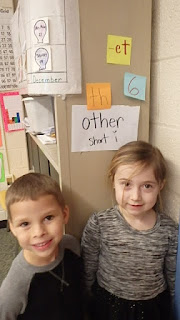(Traditional Tune)
Children form a circle as you explain that a "lassie" is a girl and a "laddie" is a boy. A girl is chosen to be the "lassie." She gets in the middle of the circle and makes a funny motion that the others must mimic as you sing. The girl then chooses a "laddie" to stand in the middle and make a motion. The game continues as girls and boys take turns leading in the game.
Did you ever see a lassie, a lassie, a lassie?
Did you ever see a lassie go this way and that?
Go this way and that way,
Go this way and that way.
Did you ever see a lassie go this way and that?
Did you ever see a lassie, a lassie, a lassie?
Did you ever see a lassie go this way and that?
Go this way and that way,
Go this way and that way.
Did you ever see a lassie go this way and that?
Did you ever see a laddie...
One of K.J.'s favorite memories from pre-k was St. Patrick's Day. They got to take off their shoes at nap time and put them in the hall. When they woke up the leprechaun had left them a Rice Crispie Treat in their shoe. It's those little things that make memories for our "little things." Here are a few other "little things" you might want to include in your lesson plans next month.
One of K.J.'s favorite memories from pre-k was St. Patrick's Day. They got to take off their shoes at nap time and put them in the hall. When they woke up the leprechaun had left them a Rice Crispie Treat in their shoe. It's those little things that make memories for our "little things." Here are a few other "little things" you might want to include in your lesson plans next month.
Hunting for Gold - Spray paint pebbles or rocks gold. (Spread out on newspaper. Spray with gold paint. Dry. Shake. Spray the other side with gold paint. Dry. Shake. Spray a third time.) Hide the pebbles on the playground before children arrive at school. Tell the children a leprechaun hid some gold for them. What fun they will have hunting for the gold nuggets!
Hint! Need a little bucket for collecting that gold? Hole punch opposite sides of a plastic cup. Insert a pipe cleaner handle and you’ve got a perfect “pot of gold.”
What If? Have children write stories (or draw pictures and dictate) what they would do if they found a pot of gold.
Leprechaun Mischief – While the children are at lunch or on the playground, turn over a few chairs, put books on the floor, and mess up the classroom. Sprinkle a little green glitter around. Have the children write stories about what they think happened.
Catch a Leprechaun - Challenge children to design “traps” to catch a leprechaun in the block center. Give children an empty sack out on the playground and see who can catch a leprechaun.
Green Snack – Eat foods that are green like celery, broccoli, lime gelatin, snap peas, edamame, etc. You could also use green food coloring to dye cream cheese, milk, yogurt or other snacks.
Leprechaun Lunch – Purchase miniature peanut butter crackers (Ritz), cookies (Chips Ahoy), and other mini-foods. Serve these on dessert plates with napkins cut in fourths. Milk or juice in medicine cups makes this a perfect snack for “wee folks.”
Field Trip - Take a field trip (on the internet) to Ireland. Find Ireland on the globe. How could you get there? Could you go in a car? Why or why not?
Math Manipulatives – Spread out dry lima beans on a newspaper. Spray paint one side gold. Dry. Flip over and spray paint the other side gold. These golden nuggets are perfect for making sets, adding, and subtracting.



















































